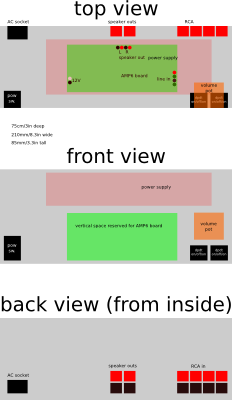my 41hz.com amp6 project
I'm building a little stereo amp based on the 41hz.com amp6 kit. I'm doing this because typical stereo receivers waste a lot of power due to being class A/B amplifiers, they're somewhat-annoyingly large, and just because I like designing/building stuff. I'm not sure if I'll be able to notice a difference in sound since I don't consider myself to have great hearing -- not to mention the fact that I'm generally listening to music from a computer with cheap on-board sound -- but the 41hz amps are considered to have very high fidelity, as are other amps based on Tripath chips in general.
I'm spending more than the minimum for decent quality parts, although it is still very cheap by "audiophile" standards. The most notable expense is the alps blue velvet potentiometer.
Another issue is "vampire power" or the trickle of power consumption that many devices exhibit when apparently turned off. This amp will be designed so that the power switch will cut off the a/c connection and no transformers or anything else will be consuming any energy when it is switched off.
controls/inputs/outputs
back panel:
- a/c power input
- two pairs of speaker binding posts
- four pairs of rca inputs
front panel:
- power switch
- mute (sleep) switch
- source 1/2/none toggle switch
- source 3/4/none toggle switch
- volume knob
parts list
| part | source | price | # |
|---|---|---|---|
| 41hz.com amp6-basic kit | 41hz | 43.43 | 1 |
| gold binding post pair | ebay | 5.00 | 2 |
| gold rca female jack pair | ebay | 3.00 | 4 |
| iec power jack | ebay | 3.00 | 1 |
| 12V 5A power supply brick | ebay | 12.00 | 1 |
| alps blue velvet 50k stereo | amb.org | 16.00 | 1 |
| shipping/handling | amb.org | 6.00 | 1 |
| spdt rocker switch | web-tronics | 1.29 | 2 |
| 8012 dpdt on/off/on toggle switch | web-tronics | 1.34 | 2 |
| shipping/handling | web-tronics | 11.65 | 1 |
| total | 107.84 |
Plus maybe $10-20 for a chassis of some sort. I'm not sure if I'll reuse something weird (like a metal lunchbox) or get one of the cheap enclosures from web-tronics (like this one).
concerns about specific parts
source selector switch(es)
Rotary switches seem to be more expensive than toggles for the same amount of switching. I don't have much personal preference, so toggles it is. Most switches have copper contacts (the parts inside which actually touch each other when switched) which are fine for most purposes, but can cause sound degradation if used with audio, especially line-level, which is relatively weak. Gold-plated contacts avoid this problem by the fact that gold doesn't oxidize, but gold contacts are usually plated over nickel, which is a comparatively poor conductor, although the real-world significance of this is questionable. Nickel is looked down upon by "audiophiles" which is of dubious validity, but we can mostly ignore the issue because switches with silver contacts seem to be more common anyway, and maybe cheaper. Silver contacts do oxidize, but the layer of silver oxide is very thin and the action of switching will generally wipe it away, not to mention the fact that silver oxide is conductive anyway, while copper oxide is a semiconductor and apparently acts as an insulator in this circumstance.
If you only had two inputs, an on/on DPDT would be appropriate, but I want four inputs, so I'll use two DPDT on/off/on switches, with one switching between source 1/2 and the other switching between 3/4. If both switches are in an "on" position, I'll have two sources mixed together, which is not something I need or want, so it will require slightly more human effort to make sure one switch is off before using the other, but that's negligible, especially since I rarely switch sources. I couldn't find any actual reviews of web-tronics, but the people at the diyaudio.com forums seem to be okay with them.
It took a long time for me to get a straight answer on whether the negatives from the input sources need to be kept separate from each other (requiring a 4PDT switch to switch both the positives and the negatives), but finally I discovered that the answer is no. You just connect all the negatives together, and only the positives go through the switches.
sketch of layout
click to enlarge
UPDATE - a new addition
I've decided that the noise encountered by analog connections from computer to amp is unacceptable anymore, so I'm going to cannibalize a Griffin iMic USB DAC and put it inside the amp. It's small, cheap, is powered by USB, is compatible with Linux with no special configuration needed, and has a good reputation for its sound quality. Wiring it in will be simple (using a USB female jack like this), and the end result will be that the line-level analog signal will only exist for a very small length of wire inside of the amp. This should reduce noise greatly.
the end, for now
I probably won't be building this until spring/summer 2009. I seem to have gotten all the parts and design figured out, so until then, this page remains to be continued...
Nick Welch <nick@incise.org> · github
